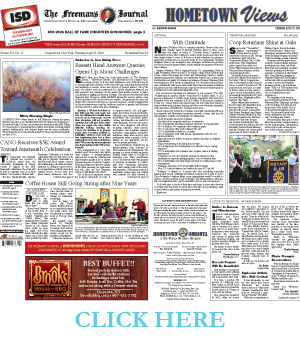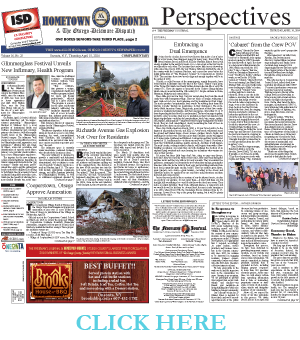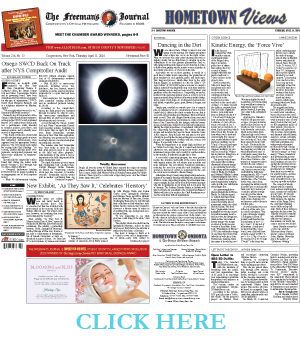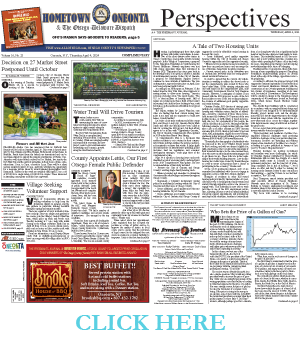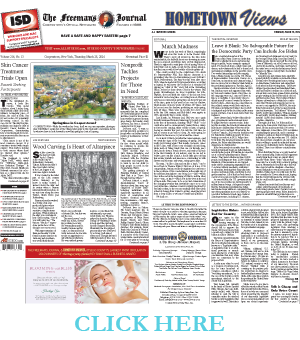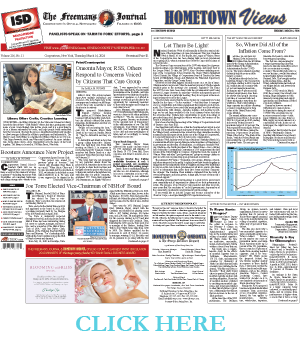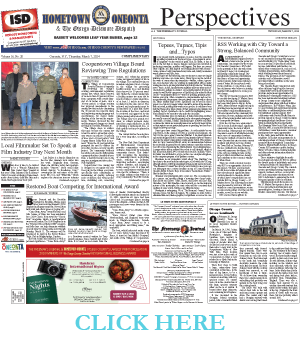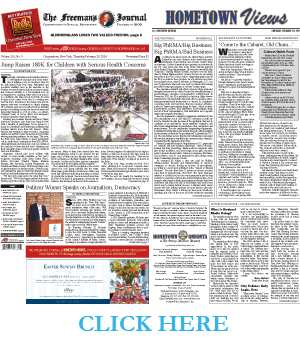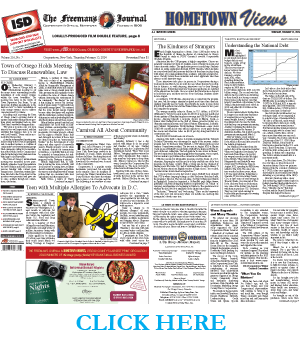THIS WEEK’S NEWSPAPERS The Freeman’s Journal • Hometown Oneonta April 25, 2024 Front Page Bassett Head Answers Queries, Opens Up About Challenges Misty Morning Magic CANO Receives $5K Award Toward Juneteenth Celebration Coffee House Still Going Strong after Nine Years Inside Weaver Farm’s Market Celebrates Fifth Year with ‘Super Sale’ School, Boosters Announce CCS Hall of Fame Class of 2024 Business District Prepares for Coming Tourist Season Rush Softball, Baseball Seasons Start News Briefs News Briefs: April 25, 2024 Editorial…
Upstate new york
THIS WEEK’S NEWSPAPERS The Freeman’s Journal • Hometown Oneonta April 18, 2024 Front Page Glimmerglass Festival Unveils New Infirmary, Health Program Richards Avenue Gas Explosion Not Over for Residents Cooperstown, Otsego Approve Annexation Inside BOCES Seniors Take Third in Contest Against College Students Pro Life, Pro-Healing ‘Empty Bowls’ Fundraiser is This Saturday Gone, But Not Forgotten Locals: People and Businesses in the News News Briefs News Briefs: April 18, 2024 Editorial Embracing a Dual Emergence Letters Nealon: In Response to…
THIS WEEK’S NEWSPAPERS The Freeman’s Journal • Hometown Oneonta April 11, 2024 Front Page Otsego SWCD Back On Track after NYS Comptroller Audit Totally Awesome New Exhibit, ‘As They Saw It,’ Celebrates ‘Herstory’ Inside Eclipse Viewing Party at SUNY Oneonta Attracts Thousands Friends of the Feral-TNR Benefit Set for Next Saturday, April 20 Flowers Are Focus of CAA Gallery Show Chamber To Honor Awards Recipients on Thursday, April 25 News Briefs News Briefs: April 11, 2024 Editorial Dancing in the…
THIS WEEK’S NEWSPAPERS The Freeman’s Journal • Hometown Oneonta April 4, 2024 Front Page Decision on 27 Market Street Postponed Until October Flowers and All that Jazz County Appoints Lettis, Our First Otsego County Female Public Defender Water Trail Will Drive Tourism Village Seeking Volunteer Support Inside Healthcare Network Welcomes Columbia-Bassett Class of 2026 Circling Back: Partnerships, Positions and Fundraising Moving Forward Report Calls for Preservation of Affordable Rental Housing CCS Boys Swim Team Wins Class C Sectional Championship News…
THIS WEEK’S NEWSPAPERS The Freeman’s Journal • Hometown Oneonta March 28, 2024 Front Page Skin Cancer Treatment Trials Open Fate of RSS Housing Project Uncertain Springtime in Cooperstown? Nonprofit Tackles Projects for Those in Need Life Sketches: Wood Carving Is Heart of Altarpiece Inside Thompson Named President, CEO of Bassett Healthcare Network Registration for NAMI Classes Now Underway Repeat Performance College Offers Celestial Events New Church Begins Morning Worship Cooperstown Center Honors Two of Its Own Manager Sought for Farmers’…
THIS WEEK’S NEWSPAPERS The Freeman’s Journal • Hometown Oneonta March 14, 2024 Front Page Boosters Announce New Project Library Offers Crafts, Creative Learning Oneonta Mayor, RSS, Others Respond to Concerns Voiced by Citizens That Care Group Inside Former Town Supervisor To Be Honored Farm to Fork Panel a Success CSO’s Annual Cabaret Returns with Special Guests, New Venue CFOC Announces Start of Awards Cycles Deadline for New Heroes Banners Nears News Briefs News Briefs: March 14, 2024 Editorial Let There…
THIS WEEK’S NEWSPAPERS The Freeman’s Journal • Hometown Oneonta March 7, 2024 Front Page Local Filmmaker Set To Speak at Film Industry Day Next Month Cooperstown Village Board Reviewing Tree Regulations Restored Boat Competing for International Award Inside Dunderberg Gallery Welcomes Composer, Pianist Friedman Museum Seeks Stories of Woodstock, 1960s GOHS Receives Historical Marker Grant Circling Back: New Dreams, Dreams Within Reach and Dreams Coming True Bassett Healthcare Network Welcomes Four Leap Day Babies News in Brief News Briefs: March…
THIS WEEK’S NEWSPAPERS The Freeman’s Journal • Hometown Oneonta February 29, 2024 Front Page Jump Raises $180K for Children with Serious Health Concerns Pulitzer Winner Speaks on Journalism, Democracy Inside First Presbyterian To Install New Lead Pastor, Associate Pastor Committee Helps New Folks Feel at Home Group Seeks To Honor Vietnam Veterans Hartwick Prof Strives To Make Art More Inclusive through AR Riley To Address Local Dems The Glimmerglass Festival Loses Two Valued Friends News in Brief News Briefs: February…
THIS WEEK’S NEWSPAPERS The Freeman’s Journal • Hometown Oneonta February 22, 2024 Front Page Richfield Awarded $4.5 Million in NY Forward Revitalization Funds Animal Art Chamber of Commerce Seeking Nominations Inside Art Garage Returns from Hiatus, Launches Community Show Oneida Indian Nation Releases Report Regional Spelling Bee Winner Headed to National Competition Regatta HoF Inductees Named Locals: People & Businesses in the News O’Connor Ties Record, Returns to States News in Brief News Briefs: February 22, 2024 Editorial Thirteen Decades…
THIS WEEK’S NEWSPAPERS The Freeman’s Journal • Hometown Oneonta February 15, 2024 Front Page Town of Otsego Holds Meeting To Discuss Renewables, Law Carnival All About Community Teen with Multiple Allergies To Advocate in D.C. Inside Diverse Voices To Be Heard at Coffee Shop Poetry Reading Double Feature at the Foothills Highlights Work of Lori Bailey News in Brief News Briefs: February 15, 2024 Editorial The Kindness of Strangers Columns The Myth Busting Economist: Understanding the National Debt News from…


